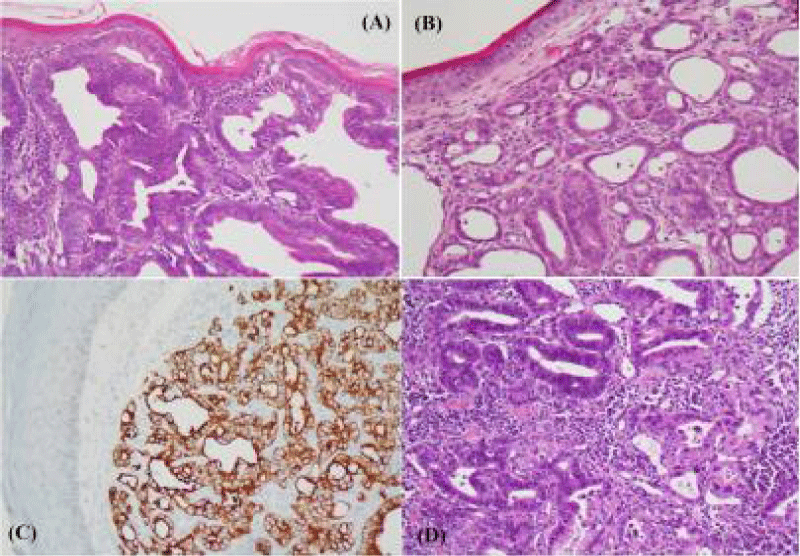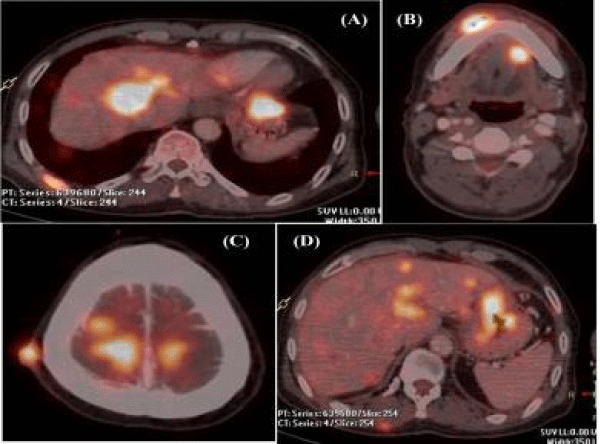Gastric Adenocarcinoma Masquerading as oral Cavity Malignancy?
Anadi Pachaury, Asawari Patil, Ankit Mahuvakar and Deepa Nair*
TATA Memorial Hospital, Dr. E. Borges Road, Parel, India
*Address for Correspondence: Deepa Nair, TATA Memorial Hospital, Dr. E. Borges Road, Parel, Mumbai, India, Tel: + 022- 241-7 70-00; Email: [email protected]
Submitted: 03 March 2020; Approved: 06 April 2020; Published: 05 June 2020
Citation this article: Pachaury A, Patil A, Mahuvakar A, Nair D. Gastric Adenocarcinoma Masquerading as oral Cavity Malignancy. Int J Case Rep Short Rev. 2020;6(5): 017-020.
Copyright: © 2020 Nair D, et al. This is an open access article distributed under the Creative Commons Attribution License, which permits unrestricted use, distribution, and reproduction in any medium, provided the original work is properly cited
Keywords: Cutaneous metastasis; Gastric adenocarcinoma; Oral cavity metastasis; Surgery
Download Fulltext PDF
Oral cavity metastatic lesions are rare (1-2% of all oral malignant neoplasms). Metastatic deposits in oral cavity soft tissues are even rarer (0.1% of oral malignancies). Breast cancer most notoriously metastasizes to jawbones, whereas oral soft tissue metastases most commonly originate from lung. Although cutaneous metastases from internal tumours are uncommon, yet sometimes they may be the first or only presentation of such malignancies, usually arising from breast, lung or large bowel. Uncommonness of oral cavity and cutaneous metastatic lesions and their subtle presentation leads to delayed diagnosis and treatment. A thorough oral cavity examination and high degree of clinical suspicion as well as multidisciplinary approach is needed while evaluating any oral cavity tumour. We intend to report an extremely rare case of adenocarcinoma stomach who presented to us with an oral metastatic lesion in lower alveolar ridge along with multiple cutaneous metastatic lesions over face and scalp.
Introduction
Oral cavity is an unusual site for metastatic tumour cell colonization (1% of all oral malignant neoplasms), mostly occurring in the bones, mandible being a cortical bone is more frequently involved compared to maxilla. Typically metastatic deposits involve areas distal to canines, including body and ramus [1]. Soft tissue deposits in oral cavity are extremely rare accounting for only 0.1% of all oral malignancies, with gingiva (50%), tongue (25%), lips and buccal and palatal mucosae being the commonest sites.
Almost 70% of all oral cavity metastatic lesions come from primaries in lung, breast, kidney, thyroid, prostate and colon, whereas cancers of stomach account for only 2.5% of all oral metastatic cases [2]. Here, we report an unusual case of gastric adenocarcinoma, whose presenting complaint was a lower alveolar growth. This case is reported for its rarity of presentation and to emphasize the need for complete histological and diagnostic imaging workup in such unusual cases.
Case Report
We report a case of a 69 year old male, known tobacco chewer presenting to the department of Head and Neck oncology with complaints of an intra-oral growth on right lower alveolus for a month. He also complained of recent onset cutaneous nodules over scalp, face, chest and back. There were no other complaints of any constitutional symptoms like dysphagia, hematemesis, haemoptysis or bone pains. On clinical evaluation, he was found to have 3 x 2 cm proliferative growth over the anterior alveolar ridge and floor of mouth on right side (Figure 1a,b). This lesion was found to be well circumscribed, not bleeding on touch and clinically free from bone. Multiple non-tender, skin nodules of 1 cm x 1 cm were seen over scalp (Figure 1c) and 0.5 cm x 0.5 cm nodules seen over right temple and right naso-labial region (Figure 1d) for the same duration. He had bilateral palpable lymph nodes (1 cm x 1 cm) in submandibular area.
An incisional biopsy of both oral and cutaneous lesions, revealed deposits of adenocarcinoma, similar in morphology. On immuno-histochemistry, these were positive for CK7 and negative for CK20, p63, S-100 and AR (Figure 2a,b,c). These features were consistent with adenocarcinoma, probably of salivary gland origin. In view of oral location, a possibility of adenocarcinoma of minor salivary gland origin, with cutaneous metastasis was suggested. Considering the histological report, it was decided to undertake a detailed systemic evaluation. A whole-body positron emission tomography showed a hyper-metabolic enhancing lesion in right lower alveolus (SUV max. 16.45) and left floor of mouth (SUV max. 13.17), with multiple metabolically active cutaneous/subcutaneous lesions in scalp, face, anterior part of chest and back, along with metabolically active liver, skeletal and lung metastasis. PET scan also detected the presence of a metabolically active lesion in wall involving proximal stomach (SUV max. 20.45) (Figure 3a,b,c,d), indicating it to be a possible site of primary, following which the patient was subjected to an Upper GI endoscopy, that revealed an ulcero-infiltrative growth in wall of proximal stomach. The biopsy from stomach revealed adenocarcinoma, which was identical to biopsy from oral and cutaneous lesions. (Figure 2d).
Patient was thus diagnosed as a case of stomach adenocarcinoma with multiple metastatic lesions involving oral cavity, soft tissues, skin, liver and lung. Due to the extensive distant metastatic spread of the malignant lesion, he was planned for palliative chemotherapy with docetaxel as well as palliative radiation for lower alveolar lesion. The patient succumbed to disease within 8 months of presentation to the hospital.
Discussion
Oral metastasis carries a grave prognosis as it represents advanced disease and may have a variable presentation, ranging from mere progressive discomfort, pain or bleeding to more serious ones like dysphagia, interference with mastication or even disfigurement. Oral cavity metastasis poses a diagnostic challenge as it is an infrequent site for metastatic tumours. Occasionally an oral cavity tumour may be the first and only evidence of the dissemination of another (previously unknown) tumour from its primary site [3]. Mandible is the most favoured site for bone metastases in head and neck region, comprising more than 70% of all oral cavity metastatic tumours [4]. Jaw metastases show a female preponderance with a strong predilection for middle-aged and older adults.
Uncommonness of oral cavity bony metastatic lesions is attributed to the scarcity of red marrow in jawbones. In dentulous patients, gingival metastasis (80% of the total oral cavity bony metastatic lesions) are seen due to the rich capillary network of the chronically inflamed gingiva entrapping malignant cells. In edentulous population, tongue and the alveolar mucosa are predominant sites [5].
Mechanism of soft tissue oral cavity metastasis from distant primaries is still obscure. Loco-regional metastasis can be easily explained through lymphatic route, which fails to explain oral metastases from lower parts of body as they should have been filtered by lungs. To explain this mechanism, Batson had proposed an alternate valve less vertebral venous plexus mechanism which bypasses the lung filtration. This system drains the blood from the caval and the azygous venous system due to increased intra-thoracic pressures [6].
Undifferentiated carcinoma (29%), and adenocarcinoma (20%) are more likely to give oral and cutaneous metastatic lesions in comparison to squamous cell carcinoma [7], with adenocarcinoma being the commonest histological type of metastatic oral and maxillofacial lesions [8], predominantly breast adenocarcinoma. The rarity of gastric adenocarcinoma metastasizing to the oral cavity can be judged by the fact that till now only 19 cases have been reported in the literature in the half century [9].
Incidence of skin metastases from internal organ malignancies is estimated to vary between 0.6 to 9% of all cases of malignant diseases [10], with breast cancers being commonest among females (18.6% - 50%) and bronchogenic carcinoma among males (3%-7.5%). Cutaneous metastasis from gastric carcinoma is rare [11], and it being the only mode of presentation is even rarer [12]. Gastric adenocarcinomas usually send their cutaneous metastases close to the primary site like umbilicus and anterior abdominal wall (“sister Mary Joseph nodule”), but rarely can they appear on the head, eyebrow, neck, axillae, chest, lip, fingertips, shoulders, arms [11].
Histological and immuno-histochemical testing of both primary and metastases are mandatory for reaching the correct diagnosis, helping not only in excluding several primary intraoral tumours like primary ductal carcinoma of salivary gland, but also in differentiating from other metastatic primaries arising from lung, colorectal, hepatocellular and genitourinary system. In female jaw metastases usually arise from breast (42%), followed by adrenals (8.5%), genital organs (7.5%), and thyroid (6%), whereas it is lungs (22.3%), prostate (12%), kidney (10.3%), bone (9.2%), and adrenals (9.2%) [13] in males.
According to Hirshberg et al. [5] in 23% of metastatic oral lesions, they were the only presentation of an undiscovered primary malignancy. In another review by Zachariades’, the bony metastatic lesion of the oral cavity was 2.5 times more common than mucosal lesions.
Treatment options are only limited to palliation and improving the patient’s quality of life, as the condition indicates widespread disease with poor prognosis. Neither radiotherapy nor chemotherapy have any definitive role but can be used for controlling local symptoms. As seen in our case, oral metastases can sometimes be the only presentation of an occult malignancy in other body sites.
Conclusion
In conclusion, metastases to the oral cavity are quite uncommon among general population. They usually present with symptoms similar to odontogenic infections and benign tumours, causing a delayed diagnosis and treatment. Consequently, careful examination and a high degree of clinical suspicion as well as a multidisciplinary approach are suggested, when examining patient with a previous history of malignancy.
- Poulias E, Melakopoulos I, Tosios K. Metastatic breast carcinoma in the mandible presenting as a periodontal abscess: a case report. J Med Case Rep. 2011; 5: 265. Pub Med: https://pubmed.ncbi.nlm.nih.gov/21722359/
- Devesa SS, Blot WJ, Fraumeni JF Jr. Changing patterns in the incidence of esophageal and gastric carcinoma in the United States. Cancer. 1998; 83: 2049-2053. https://bit.ly/3gXvQtS
- Piattelli A, Fioroni M. Gingival metastasis from a prostate adenocarcinoma: Report of a case. J Periodontal. 1999; 70: 441-444. PubMed: https://pubmed.ncbi.nlm.nih.gov/10328657/
- Aniceto GS, Penin AG. Tumors metastatic to the mandible: Analysis of nine cases and review of literature. J Oral Maxillofac Surg. 1990; 48: 246-251. https://bit.ly/2ACJn9M
- Hirshberg A, Shnaiderman-Shapiro A, Kaplan I, Berger R. Metastatic tumours to the oral cavity -pathogenesis and analysis of 673 cases. Oral oncology. 2008; 44: 743-752. PubMed: https://pubmed.ncbi.nlm.nih.gov/18061527/
- Hirshberg A, Berger R, Allon I, Kaplan I. Metastatic tumours to the jaws and mouth. Head Neck Pathol. 2014; 8: 463- 474. PubMed: https://pubmed.ncbi.nlm.nih.gov/25409855/
- Hashimoto N, Kurihara KH, Ohba S, Sakaii HY, Oshida S. Pathological characteristics of metastatic carcinoma in the human. J Oral Pathol. 1987; 16: 362-367. PubMed: https://pubmed.ncbi.nlm.nih.gov/3117991/
- Jham BC, Salama AR, McClure SA, Ord RA. Metastatic tumours to the oral cavity: A clinical study of 18 cases. Head Neck Pathol. 2011; 5: 355-358. PubMed: https://pubmed.ncbi.nlm.nih.gov/21805337/
- Sauerborn D, Vidakovic B, Baranovic M, Mahovne I, Danic P, Danic D. Gastric adenocarcinoma metastases to the alveolar mucosa of the mandible: a case report and review of the literature. J Craniomaxillofacial Surg. 2011; 39: 645-648. PubMed: https://pubmed.ncbi.nlm.nih.gov/21112790/
- Lookingbill DP, Spangler N, Helm KF. Cutaneous metastases in patients with metastatic carcinoma: A retrospective study of 4,020 patients. J Am Acad Dermatol. 1993, 29:228-236. PubMed: https://pubmed.ncbi.nlm.nih.gov/8335743/
- Navarro V, Ramon D, Calduch L, Llombart B, Monteagudo C, Jorda E. Cutaneous metastasis of gastric adenocarcinoma: an unusual clinical presentation. Eur J Dermatol. 2002; 12: 85-87. PubMed: https://pubmed.ncbi.nlm.nih.gov/11809606/
- Ng Ky, Ng HS, Ong YY, Ong BH, Giam YC. Cutaneous metastases-an uncommon and unusual mode of presentation of gastric carcinoma. Singapore Med J. 1989; 30: 97-101. PubMed: https://pubmed.ncbi.nlm.nih.gov/2595397/
- Hirshberg A, Leibovich P, Buchner A. Metastatic tumors to the jaw bone: Analysis of 390 cases. J Oral Pathol Med. 1994; 23: 337-341. PubMed: https://pubmed.ncbi.nlm.nih.gov/7815371/



Sign up for Article Alerts